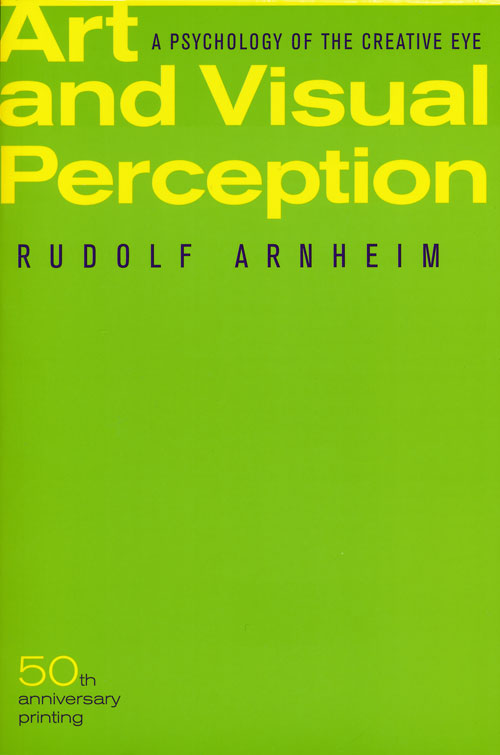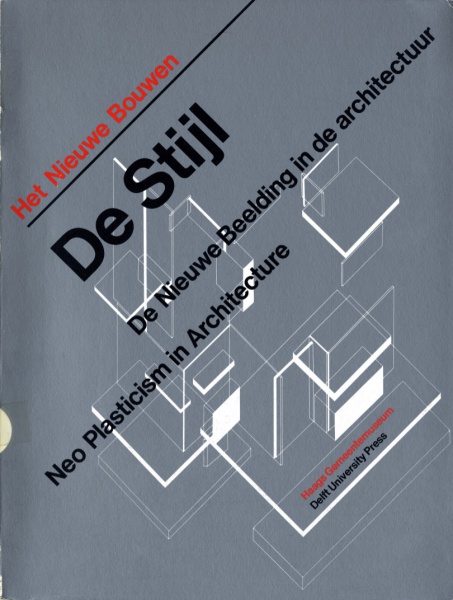Rudolf Arnheim: Art and Visual Perception (1954–) [EN, RU, PL, RO, ES, BR-PT]
Filed under book | Tags: · architecture, art theory, colour, kinesthesia, light, movement, music, painting, perception, perspective, physiology, psychology, sculpture

“Since its publication in 1954, this work has established itself as a classic. It casts the visual process in psychological terms and describes the creative way one’s eye organizes visual material according to specific psychological premises. In 1974 this book was revised and expanded, and since then it has continued to burnish Rudolf Arnheim’s reputation as a groundbreaking theoretician in the fields of art and psychology.”
Publisher University of California Press, 1954
Expanded and revised edition, 1974
ISBN 0520243838
508 pages
Interview with the author (Uta Grundmann, Cabinet, 2001)
Publisher (EN)
Art and Visual Perception (English, 1954/1974, 26 MB)
Iskusstvo i vizualnoe vospriyatie (Russian, trans. V.N. Samokhin, 1974/2000, DJVU, no OCR)
Sztuka i percepcja wzrokowa (Polish, trans. Jolanta Mach, 1978, 24 MB, no OCR, via nuitienne)
Arta si perceptia vizuala (Romanian, trans. Florin Ionescu, 1979, 35 MB, no OCR, via)
Arte y percepción visual (Spanish, trans. María Luisa Balseiro, 1979/1997, 43 MB)
Arte e percepção visual (Brazilian Portuguese, trans. Ivonne Terezinha de Faria, 1980/2005)
Het Nieuwe Bouwen: De Stijl: Neo Plasticism in Architecture (1983) [English/Dutch]
Filed under book, catalogue | Tags: · architecture, art, art history, art theory, de stijl, functionalism, history of architecture, neoplasticism

“In 1975, as a result of intensive teamwork, the Netherlands Museum of Modern Architecture, the Stedelijk Museum in Amsterdam, the Gemeente Museum in The Hague and the Rijksmuseum Kröller-Müller at Otterlo presented a variegated picture of Dutch architecture from 1890 to 1930 in four exhibitions. The interest in them was so great that it was decided almost at once to take up a similar project again after a few years, this time on the subject of ‘Nieuwe Bouwen’ and the Netherlands 1920-1960. That undertaking has now resulted in five exhibitions (a new participant being the Boymans-van Beuningen Museum in Rotterdam), each of which shows a different aspect of ‘Nieuwe Bouwen’, from its prior history to its latter days. ‘Nieuwe Bouwen’ or Functionalism was a worldwide phenomenon which began to appear after the First World War. The realization that a new society was imminent was felt by many to demand radical new solutions to social, economic and cultural problems. In the Netherlands the first contribution to the stating of those problems was made by the artists and architects who had united in the De Stijl movement.” (from the Foreword)
With texts by Theo van Doesburg, Henk Engel, Pieternel Fortuyn, Jan de Heer, Cees Boekraad, Yve-Alain Bois, Umberto Barbieri and Herbert Henkels.
Het Nieuwe Bouwen: De Stijl: De Nieuwe Beelding in de architectuur. Neo-Plasticism in Architecture
Edited by Cees Boekraad, Flip Bool, Herbert Henkels
With an Introduction by Cees Boekraad
Publisher Delft University Press, Delft, and Haags Gemeentemuseum, Den Haag, 1983
ISBN 9062751040
179 pages
via TU Delft
PDF (327 MB)
Comment (0)Craig Dworkin: No Medium (2013)
Filed under book | Tags: · architecture, art, art theory, attention, body, book, conceptual art, dada, film, fluxus, literature, media, music, painting, paper, phonograph, sculpture, sex, silence, temporality, time, translation, typography
“In No Medium, Craig Dworkin looks at works that are blank, erased, clear, or silent, writing critically and substantively about works for which there would seem to be not only nothing to see but nothing to say. Examined closely, these ostensibly contentless works of art, literature, and music point to a new understanding of media and the limits of the artistic object.
Dworkin considers works predicated on blank sheets of paper, from a fictional collection of poems in Jean Cocteau’s Orphée to the actual publication of a ream of typing paper as a book of poetry; he compares Robert Rauschenberg’s Erased De Kooning Drawing to the artist Nick Thurston’s erased copy of Maurice Blanchot’s The Space of Literature (in which only Thurston’s marginalia were visible); and he scrutinizes the sexual politics of photographic representation and the implications of obscured or obliterated subjects of photographs. Reexamining the famous case of John Cage’s 4’33”, Dworkin links Cage’s composition to Rauschenberg’s White Paintings, Ken Friedman’s Zen for Record (and Nam June Paik’s Zen for Film), and other works, offering also a “guide to further listening” that surveys more than 100 scores and recordings of “silent” music.
Dworkin argues that we should understand media not as blank, base things but as social events, and that there is no medium, understood in isolation, but only and always a plurality of media: interpretive activities taking place in socially inscribed space.”
Publisher MIT Press, 2013
ISBN 0262018705, 9780262018708
219 pages
Interview with the author (Critical Margins)
Author’s lecture at Penn Poetry & Poetics (video, 19 min)
Reviews: Johanna Drucker (Los Angeles Review of Books), Michael Leong (Hyperallergic).
Commentary: Richard Marshall (3:AM Magazine).


